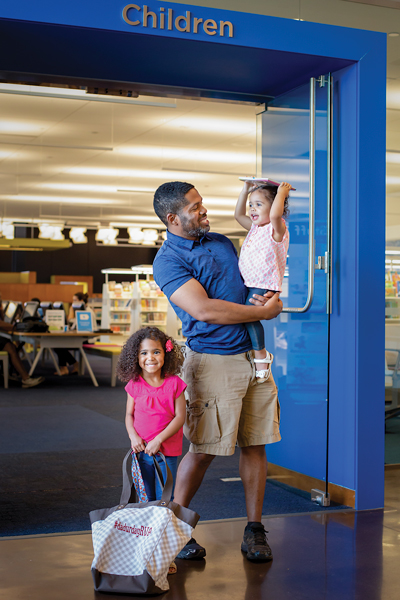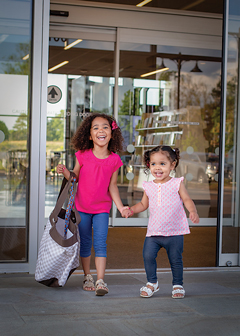Have you ever wondered how to ensure your children understand the importance of lifelong learning? I started by showing my daughters, ages four and two, where it can take place – at the library.
Not only is the library a place that offers learning as entertainment, it also provides bonding time for families and lessons on responsible citizenship. The best part is it’s all free! And who wants to pass up free entertainment? Of course, when you think of a library, you think of books. There are thousands of books to enjoy, and they are all free. Books open the mind to imagination. When you have imagination, you gain inspiration and motivation. With this in mind, I set a goal with my two daughters: To visit a library weekly and read 365 new books each year.

Books and reading are amazing, but the libraries in the greater Richmond area offer many different resources. They have DVDs for a family movie night (after you read the book, of course!), special events, author talks, arts and crafts, and story times.
Now that you know what the library can offer, it’s time to plan your visit. Because I’ve been there too many times to count with my daughters, I have a few tips:
1. Talk up the library.
Each time we visit the library, I talk it up like I am a hype man at a concert. I say things such as, “Do you remember that book about the colors from our last visit? Maybe you can find another book about colors?” or “You asked me about riding a bike – do you think the library has a book about riding bikes?” I love to get my 4-year-old super-excited about our trip.
2. Review library etiquette.
Most parents know you will have to repeat yourself 10,000 times before the correct behavior actually happens. I like to start setting expectations before we go to the library and repeat myself each time we go. At the library: we walk, take one book off the shelf at a time, talk in a soft voice, listen to Daddy, and return any toys we borrow back where they belong. Be sure to ask the librarian about other specific rules at that library branch. This is important for the simple fact that some libraries have children’s areas where kids can interact with each other.
3. Visit different libraries.
If you have a library branch that is close to your home, like we do, good for you! I know it’s tempting to always go to the same library. I also know there are a few new library branches in Richmond – Libbie Mill Library and Varina Library, both in Henrico County – and they are amazing facilities. Take your kids to different libraries so they can meet different families and see different areas of Richmond.
4. Allow exploration.
Children want to look at everything! My daughters want to sit in every chair in the library. Many libraries have puzzle and board game areas and play tables, and this is where we spend about 40 percent of our time. The other 60 percent is for looking at all the books on the shelves.
5. Learn the checkout/return process.
Before you take your little one to the library for the first time, I suggest demonstrating how to return the books. When you do this, the kids can begin to understand that these books are not theirs to keep, but to borrow, and that the books must be returned. Don’t forget to bring a bag for the many books you will check out. I use a sturdy canvas bag a friend made for me.
6. Pick out books.
Most kids will just grab books off the shelf. Normally, I wouldn’t say to select a book by its cover, but preschoolers are enticed by the cover of the book. As kids get older, you
can help them become more interested in reading the book. My daughters typically ask for characters from books we have already read, and we will look for more books with those characters. Often, we think of a topic, such has “helping others.” We will ask the librarian where we can find books with this theme. When your kids are older, teach them how to use the computer database. If there is a topic you want them to explore – pet care, for example – they can search for key words in the database and then pick from all the books listed.
7. Take care of books.
This is an important one. Once the books make it home, teach your kids that these books are library books. All books should be respected, but library books are extra special. They need to be treated with even more care. I know from experience that accidents happen. Here are some suggestions to minimize book damage:
• Find a special spot in your house just for library books. We have an end table where we stack library books. Once we finish reading a book, we place it in the library bag.
• Keep books away from areas where you use crayons and other craft materials.
• Keep a close eye on toddlers. They aren’t quite sure how to handle books with care.
The library is a wonderful place to take a toddler, preschooler, or any child. This time of year, don’t forget to sign up for the summer reading challenges. Most libraries offer great prizes to kids who participate, from elementary school to high school students. For younger kids, many libraries have a story time. These story times are great for early literacy and teaching kids how to sit and listen to someone – other than Dad. High school kids can also apply to volunteer at the library during the summer.
Making the library a fun place can be easy if you know what the library has to offer. This summer, we’ll read, explore, laugh, dream, and fall in love with many books. The library has become our learning playground. I hope we see you there!

Raising Readers!
My girls are four and two, and we have been reading since day one. When they were born, I pledged to read them a different book each day throughout the year. This process was a way for us to spend time with each other and have fun while learning. Over the years, I have come to realize that I enjoy reading with my littles a lot more than I thought I would.
Here are some ideas to make reading fun for you and your kids:
1. Relate a book to an event or someplace you will be going. For example, read a book about the zoo before you go to the zoo.
2. In my household, we play a I Spy with all the books when we read.
3. Ask kids questions as you read. And make sure you wait for an answer. You can learn so much about your child by the answers she gives.
4. If your kids enjoy a book, read it, again, and again – until you both get tired of the book. I have read Baa, Baa, Black Sheep by Jane Cabrera twelve times in one sitting. When you read the same book over and over, kids learn the words quickly. It can expand a toddler’s attention span and build enthusiasm for reading.

The Perrault Family’s Four Favorite Books
Baa, Baa, Black Sheep by Jane Cabrera
A new twist on an old classic rhyme with illustrations on each page that will have you examining for every detail.
The Bunny Rabbit Show! by Sandra Boynton
Interactive book that has us hopping everywhere.
Down by The Bay by Raffi
We like the cadence of this book, we even started to make our own rhymes when we read it
Girl of Mine by Jabari Asim
A wonderful bedtime story.





